#like 16th century art is dope
Photo


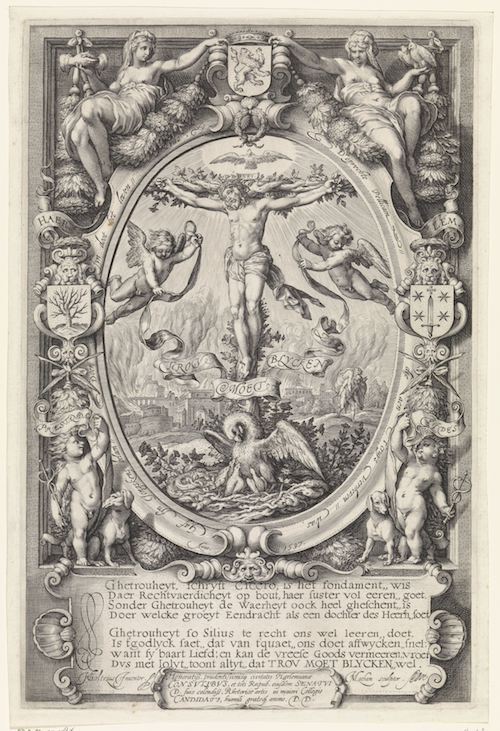
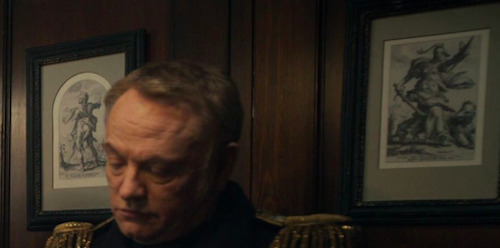

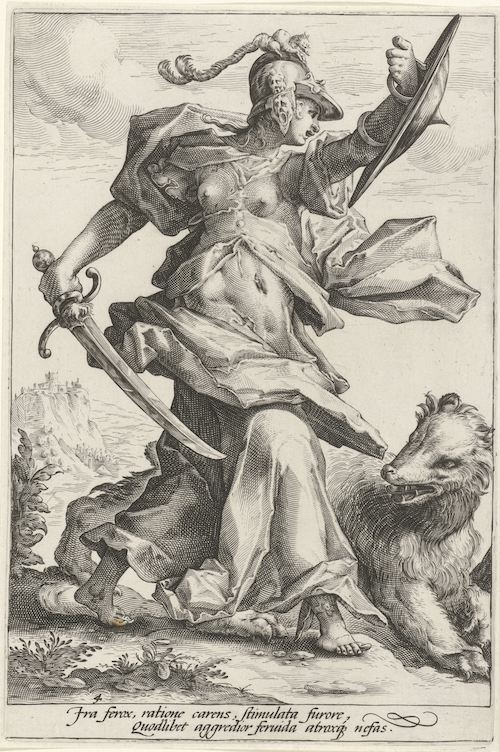
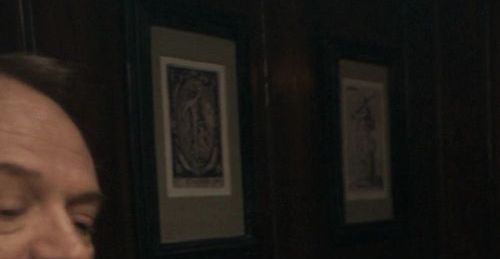
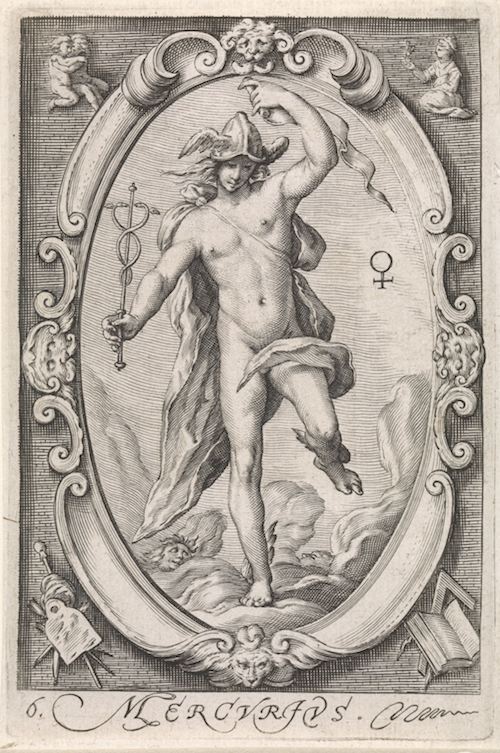

Art of the Terror Wardroom
You can hardly miss the conspicuous art adorning the walls of the Terror wardroom, floating in and out of view behind the heads of our beloved officers during the dinner scenes of our favourite show. For those of you who’ve been itching to take a closer look, I hope to provide some relief with this post.
A series of 6 prints decorate the left wall when looking down toward the head of the table. These engravings were made by the same artist, Hendrick Goltzius (1558-1617). From left to right:
1. ‘Saturn’ from the series, ‘Gods in Niches’ (1592).
2. ‘Crucifixion in Allegorical Frame’ for Trou Moet Blycken, a historical rhetoricians’ chamber in Haarlem, Netherlands (1597).
3. ‘Samson’ from the series, ‘Heroes and Heroines from the Old Testament’ (1585-9).
4. ‘Anger’ from the series ‘The Vices’ (1585-9). (Yes, that’s a bear.)
5. ‘Mercury’ from the series, ‘The Planets’ (1597; print-maker Jacob Matham). [EDIT: More likely this version.]
6. ‘Fortitude’ from the series, ‘The Virtues’ (1585-9). [EDIT: More likely this version.]
And lastly, there is one other painting in the room. It’s on the opposite wall and near the foot of the table.
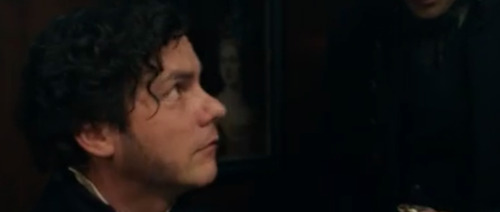
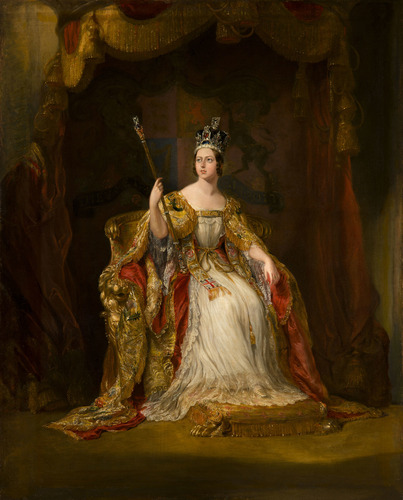
7. A portrait, ‘Queen Victoria’ (1938) by Sir George Hayter (1792-1871). The image in the wardroom appears to have been cropped from this painting.
That’s all for the Terror Wardroom! Watch this space for the Erebus Wardroom.
<Note: I have tried to identify the art from the show and provide dates and links as best I can; I cannot guarantee my findings are correct.>
#the terror#art of the terror#hms terror#wardroom#this took...a long time#and i pretty much only wanted to know what number 4 was but you know how it is#its ok i learned things along the way#like 16th century art is dope#rijksmuseum i am coming for u#soon
459 notes
·
View notes
Text
Sex and Scandal at the Court of Charles II’ on King Charles II and His Lovers. – WWD
https://pmcwwd.files.wordpress.com/2020/04/shutterstock_editorial_7525530a.jpg?w=640&h=415&crop=1
LONDON — Britain’s King Charles II, with his big wig and little moustache, his love of masquerade balls and bug-eyed spaniels, is, along with King Henry VIII, a monarch with a grip on the British imagination.
The symbol of Restoration England, Charles was the sporty, tall and handsome “merry monarch” who restored the theaters when he returned to England after a youth spent in peripatetic exile on the Continent; the founder of The Royal Society, the oldest national scientific institution in the world, and the king who tapped Sir Christopher Wren to rebuild London after the Great Fire. Without Charles’ royal patronage there would have been no St. Paul’s Cathedral, Kensington Palace, Chelsea Royal Hospital or even No. 10 Downing Street.
Barbara Palmer as Mary Magdalene painted by Sir Peter Lely.
Photo Courtesy of Picador
Charles was also a diehard philanderer, often referred to as “the father” of England, with 14 children by seven mistresses, but none by his long-suffering Portuguese wife Catherine of Braganza. His various descendants include Princess Diana, Sarah Ferguson, former Prime Minister David Cameron, former First Lady Samantha Cameron, the Duchess of Cornwall, and scores of others. When Prince William becomes king, he will be the first British monarch directly descended from Charles II, through his mother’s family.
The king’s amorous exploits are so embedded in the culture here that schoolchildren can rap out the names of his mistresses as they sing along to “King of Bling,” which is based on Eminem’s “My Name Is,” from the hit BBC TV Series “Horrible Histories.”
Charles is also remembered for his chaotic early life, and for the difficult backdrop against which he ruled: His father, King Charles I, had been executed by Oliver Cromwell and his Puritan allies, and the young Charles, his siblings and mother spent years drifting around the Continent, borrowing money from family, including first cousin, King Louis XIV of France, and leaning on friends.
Louise de Kéroualle
Photo Courtesy of Picador
The England that Charles returned to in 1660, aged 30, unmarried, and already the father of numerous children, was still fraught with religious, political and moral tensions. His 25-year reign was marked by battles with Parliament, constant money worries, dubious alliances with his French cousins, a debauched court — not to mention the ever-present threats of bubonic plague, smallpox and syphilis. His reign took in the Great Fire of London, and a period known as the Little Ice Age, when temperatures plummeted across Europe.
In her latest book, “Mistresses: Sex and Scandal at the Court of Charles II” (Picador), the historian Linda Porter looks at the king through the lens of his Portuguese queen, Catherine of Braganza, and a string of mistresses. In doing so, Porter sheds light on the mood of the country and the court in those colorful Restoration years — and on the character of the bewigged man himself.
It’s a pretty radical view: Although the king died in 1685, his antics, personal and political, continue to bewitch historians and writers who have long been indulgent of the Stuart king. She’s not buying the hype.
“He’s gone down in British history as the merry monarch, and people still think of him as a nudge-nudge, wink-wink sort of jolly good fellow type. But I don’t see him that way: He was obviously a man of considerable, but lazy, intellect and he didn’t like the business of ruling. He chose quite competent ministers — and was quite willing to set them against each other,” says Porter in a telephone interview from her home near London.
Hortense Mancini
Photo Courtesy of Picador
“I think in terms of human feeling, he is a more approachable and likeable person than Henry VIII. But in terms of the way he actually conducted himself, I think he thought he was above the criticism of the country.”
Porter says she finds it hard to like Charles because his treatment of his wife is “quite appalling. One of the things I’ve tried to do to rehabilitate her reputation. She’s not the sort of weepy dope that people think she is.” Catherine, a devout Catholic who was unable to conceive, didn’t exactly have it easy with a husband like Charles, who paraded his shrewd young mistresses in front of her for their entire 23-year marriage.
Loyal, strong and undeterred by her skirt-chasing husband, she made the best of her situation. Catherine brought her fabulous, exotic taste in interiors, art and music to the royal court and famously introduced tea drinking — for pleasure rather than medicinal purposes — to the English. After Charles’ death she returned to Portugal and acted as regent for her brother Dom Pedro II, negotiating trade deals and winning the respect of British, French and Iberian rulers alike.
Lucy Walter, who bore Charles his first son, James, Duke of Monmouth and Buccleuch.
Charles was lucky to have Catherine by his side but he took little notice: He was too busy with the scheming and scandal-prone Barbara Palmer, an upper-class lady with whom he had five children, and with Nell Gwyn, the poor orange seller-turned-actress and a big-hearted spendthrift whose lavish dinner parties were the talk of society.
He was also spending considerable amounts of time with Louise de Kéroualle, a minor French noble with the delusions of a political power broker; Moll Davis, a singer and dancer whose legs the king couldn’t resist, and the beautiful — and unconventional — Hortense Mancini, who was on the run from her maniacal husband.
These ladies — and others — competed simultaneously for the king’s affections, his power and his (unstable) finances as they fought to secure property, titles and regular incomes for themselves and their illegitimate children.
These women also took lovers (to keep themselves occupied between royal trysts) and sought to make advantageous marriages for themselves or their children. Lucky for them the king was a generous sort: He never truly abandoned his lovers, or had them killed. And no matter how much time passed or how many women Charles was juggling, he retained an “easy affection” for his lovers, and his children.
Porter also writes about the publicity these women sought — shamelessly commissioning portraits of themselves as saints or goddesses — and the abuse they were willing to suffer at the hands of courtiers, pamphlet writers, gossips and sometimes their own family members because of their liaisons with the king.
Linda Porter, the historian and non-fiction author.
Photo courtesy of Linda Porter
The book includes a vile poem (unprintable here) about the ambitious Barbara Palmer, written by one of her relatives, George Villiers, the Duke of Buckingham. Porter rightfully points out that “even today’s celebrities, accustomed to the viciousness of Twitter, might be shocked by the obscene verses and pamphlets aimed at Barbara.”
These women were the founders of some of the biggest, wealthiest British families, and while their portraits still hang in galleries throughout Europe, “their place in British history, and their influence, is somewhat ephemeral,” admits Porter. “But that doesn’t make them any less fun to read about.”
Interesting and dynamic, “they were the most glamorous set of women from 17th-century England, a bit like what the six wives of Henry VIII are to the 16th century, except there are even more of them. And we know more about them because they’re a century closer to us. We’ve got more of their letters, and they are just more accessible,” says Porter.
Despite having studied Charles and his family in depth (one of her previous books is “Royal Renegades: The Children of Charles I and the English Civil Wars”) Porter admits that, in some ways, she is still no closer to knowing the merry monarch. “Charles was an inscrutable man. I once described him as an enigma even to himself.”
For her next book, Porter is crossing the Channel and turning her attention to another colorful and divisive figure — although with a much larger wig: Marie Antoinette. Porter, who has a doctorate in history from the University of York, and whose specialization was the early modern English and French era, says she’s eager to return to her studies of the French Revolution.
Her plan is to write a book called, “To Kill a Queen: The Last Days of Marie Antoinette.” She believes there’s a lot of information about the controversial queen that is not well-known — or not translated into English — and she’s eager to dive into it.
“Most biographers of Marie Antoinette gallop over her last year in record time, and concentrate much more on her childhood and the period of queen at Versailles, and all that. But I like the Revolution.”
Source link
قالب وردپرس
from World Wide News https://ift.tt/3bkHKtR
0 notes
Text
The Daily Tulip
The Daily Tulip – News From Around The World
Wednesday 1st August 2018
Good Morning Gentle Reader…. Well August is upon us and it’s only 146 days to Christmas.. My! How the time flies….. But having just returned from my morning walk with Bella I’m not so worried about Christmas as I am in getting a cup of coffee, Boy! It’s so very hot this morning plus we have humidity to deal with, the first thing Bella did was drink the fresh water I put down before we go out, and then flop on to the cool marble floor and she’s now snoring, Dogs.. you have to love them…
BELARUS CUSTOMS FIND ANTLER HORDE HIDDEN IN FUEL TANK…. Belarusian customs officers have stopped a man trying to smuggle more than 90 kg (14 stone 180lbs) of antlers into the country, hidden in the fuel container of a car. The officers at the Makrany border crossing in the west of the country were suspicious of the car heading straight for the green "nothing to declare" channel as it approached from Ukraine, the Belaruski Partyzan news site reports. The driver, a 21-year-old unemployed man from the Brest Region of western Belarus, submitted a written declaration that he was bringing no goods into the country, but the officers stopped the car and searched the interior thoroughly. They found nothing untoward until they opened a spare fuel container, only to discover it was crammed full of sawn-off deer antlers. The customs officers estimate the illegal haul could have earned the smuggler more than 3,500 Belarusian roubles, or about $1,750 (£1,340). The importation of deer antlers for decorative use is not banned in Belarus, but they must have duty paid on them and be accompanied by a veterinary certificate testifying that they were obtained in a legal and humane manner. The driver faces charges, and his car has been seized as evidence, according to the Customs Service of Brest Region.
FACEBOOK BANS FLEMISH PAINTINGS BECAUSE OF NUDITY…. The Flemish tourist board has issued a complaint to social media network Facebook, after it removed a number of posts featuring paintings by Flemish artists for nudity, it's reported. According to Belgium's VRT News Flemish-language public broadcaster, a number of social media posts have recently been taken down that feature paintings by artist Peter Paul Rubens. Rubens (1577-1640) was one of the most influential artists of the 17th century, and was famous for his Baroque paintings, many featuring nudes and cherubs. Toerisme Vlaanderen says that it has issued an open letter to Facebook chief Mark Zuckerberg, saying: "We have noticed that Facebook consistently rejects works of art by our beloved Peter Paul Rubens.
"Even though we secretly have to laugh about it, your cultural censorship is making life rather difficult for us." Peter De Wilde, the CEO of Visit Flanders, tells VRT News: "Most Flemish museums have signed the letter". But The Brussels Times notes that it may be a "playful protest" to attract tourists to exhibitions hosted by the Visit Flanders agency. A number of "Paintings by Flemish Masters" exhibitions are currently underway at a number of Visit Flanders locations in northern Belgium. The Brussels Times notes that the Flemish Office has a 2018-2020 cultural plan to promote the works of Rubens, as well as other 15th-17th century Flemish painters including Pieter Bruegel the Elder and Jan van Eyck.
KENYAN TV UNVEILS HUSBAND AND WIFE NEWS TEAM…. Kenya is getting a husband and wife team to present the news for the first time, in what's seen as a little bit of national television history. Leading Swahili TV news presenter Lulu Hassan took to the air yesterday to present Citizen TV's Swahili-language bulletin alongside her husband Rashid Abdalla. Ms Hassan presents the popular Nipashe Wikendi programme on what is Kenya's most popular TV station. The pairing has been touted as the first ever married couple to present the news on Kenyan television. "Welcome Rashid Abdalla, please feel at home," Hassan said, as her husband took his seat alongside her. "This is good collaboration," he replied, before adding more cryptically: "It is a partnership similar to how the hands and eyes coordinate". There was extensive publicity about the pairing before the couple's debut news programme together, yet neither mentioned their relationship on air. However, many online users have noted that Ms Hassan briefly tapped her husband on the hand as they signed out. Mr Abdalla is a new recruit to the programme, replacing previous anchor Kanze Dena, who was recently appointed by Kenyan President Uhuru Kenyatta as his deputy spokesperson. He was recruited from rival network NTV, part of the media group which owns Kenya's Nation newspaper. Kenyan social media seemed amused by the husband-and-wife team, with one user asking: "Would you work with your other half at the same place?" The Kenyans.co.ke website saluted the emergence of the new "power couple" , saying they "didn't disappoint"; quoting enthusiastic social media users who said - among other things - "this combination is dope".
UZBEK TV CHANNEL APOLOGISES OVER STEAMY SCHUMER SCENE…. A television channel in Uzbekistan has apologised profusely for allowing a bedroom scene from a Hollywood film to make its way onto domestic screens, it's reported. Privately-owned entertainment channel Sevimli TV said a "technical failure" meant that an uncut version of 2018 comedy I Feel Pretty was shown, complete with a raunchy scene where star Amy Schumer kisses and cuddles a male character on a bed, CA News reported.
Uzbekistan, Central Asia's most populous country, often censors films shown on TV. The bedroom scene was said to have been aired "contrary to the Uzbek mentality" which "trampled on the spirit of the nation", a campaign to force an apology from the channel declared. A remorseful Sevimli TV said it had sacked all staff members responsible for letting the "immoral scene" slip through. "Everyone makes mistakes," it said, promising to be more careful in future. Later reports said that Sevimli had dismissed three employees over the incident. I Feel Pretty stars Amy Schumer as an insecure woman who becomes super-confident about herself after suffering a head injury. It was given a 12A certificate by the British Board of Film Classification, which says it contains "moderate sex, sex references, and language". Many nationals commenting on social media about the incident thought that sacking people for not removing the scene was a step too far. "What kind of old moralists are working at our TV channels, who force people to cut out kissing scenes and even some phrases and words? This is something that everyone has already seen; you are not going to surprise anyone with erotic footage," one Facebook user said. Others say that censorship of sex on the nation's screens is a hangover from the years Uzbekistan was part of the Soviet Union. "There was no sex in the USSR, and it still does not exist in Uzbekistan. But has anyone ever wondered where we got 32 million people?" another user asked.
ALL-MALE SHAKESPEARE CAST CAUSES SEXISM ROW…. The founder of Auckland's Pop-up Globe theatre in New Zealand has apologised for casting only male actors in forthcoming productions and using the #MeToo campaign hashtag to promote them.
The theatre group is to perform Richard III and The Taming of the Shrew in its forthcoming season on the abuse of power, and founder Miles Gregory has stuck with the 16th Century tradition of casting men in female parts, national broadcaster Radio New Zealand reports. However, there's been upset that the theatre used hashtags used by equality movements to highlight misogyny and sexism in a press release announcing the productions. "In the age of Weinstein, #metoo and #timesup, it feels entirely right for us to reflect current conversations in the world through ambitious and thought-provoking programming," the theatre company said.
But this has led to a call to boycott the theatre and for sponsors to withdraw their support, the Stuff news website reports.
Well Gentle Reader I hope you enjoyed our look at the news from around the world this, morning… …
Our Tulips today are very Yellow…

A Sincere Thank You for your company and Thank You for your likes and comments I love them and always try to reply, so please keep them coming, it's always good fun, As is my custom, I will go and get myself another mug of "Colombian" Coffee and wish you a safe Wednesday 1st August 2018 from my home on the southern coast of Spain, where the blue waters of the Alboran Sea washes the coast of Africa and Europe and the smell of the night blooming Jasmine and Honeysuckle fills the air…and a crazy old guy and his dog Bella go out for a walk at 4:00 am…on the streets of Estepona…
All good stuff....But remember it’s a dangerous world we live in
Be safe out there…
Robert McAngus
#Tulips
#Spain
#Bella
#Christmas
0 notes